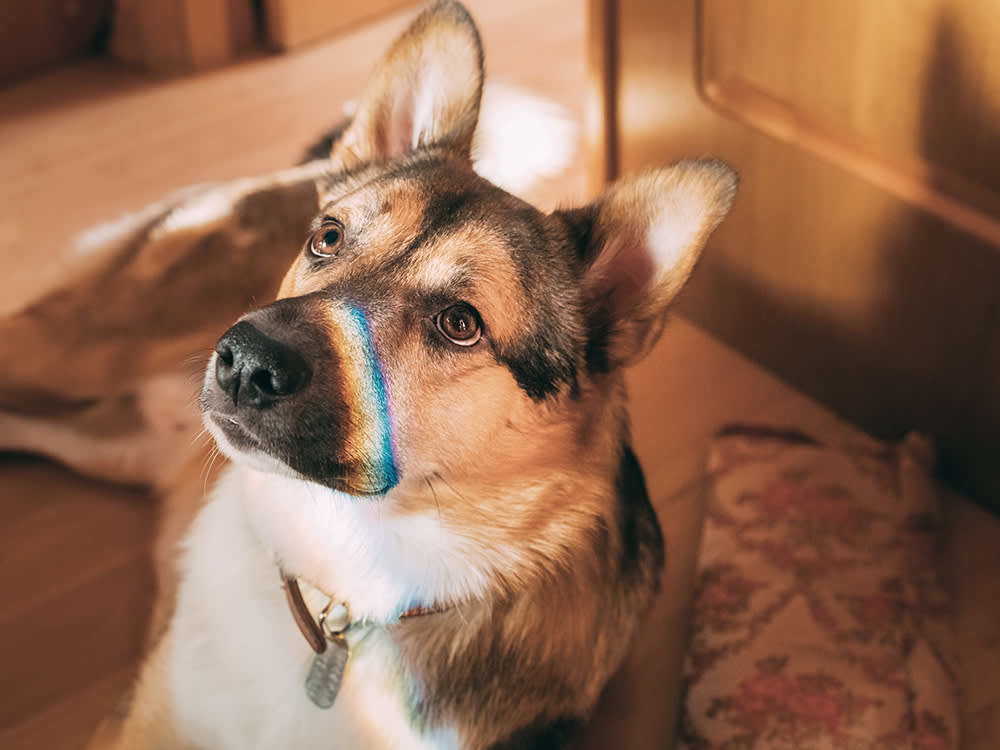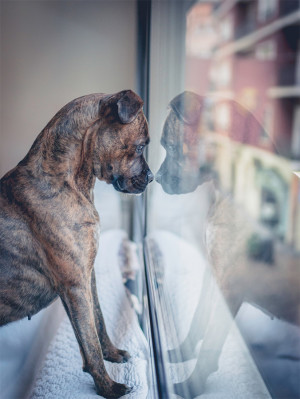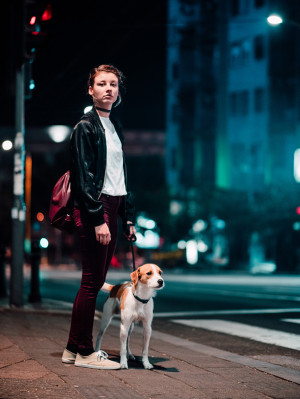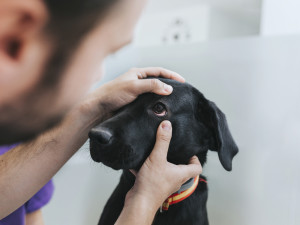What Colors Can Dogs See? How Dog Vision Really Works
Let’s put a stop to this “dogs are totally color blind” myth.

Share Article
In This Article:
Can Dogs See Color? Are Some Dogs Color Blind? How Does a Dog’s Vision Work and What Do They See? How Does a Dog’s Vision Differ From Human Vision? Does Vision Change Across Different Dog Breeds? Can Dogs See in the Dark? Common Misconceptions About Dog Vision
Goldfish have a three-second memory, toads can give you warts, and dogs are color blind… sound familiar? Well, these along with many other antidotes that we’ve all been told aren’t actually true. While I’d love to dive into the inner workings of the fish brain, instead we’re going to focus on the colors that dogs can see.
Rather than living in a world of shades of gray, dogs actually enjoy quite a bit of color.

Can dogs see color?
Dogs’ eyes are very similar to humans in a lot of ways. They are also different in a lot of ways, making a dog’s vision unique and even a little mysterious. One thing we do know is that dogs are able to see some colors, not just black and white.
What colors can dogs see?
Dogs are able to see varying shades of yellow and blue. They can’t see red or green, so that bright red ball you bought them or the green of your lawn likely looks more gray or brown. The blue of the leash, on the other hand, would be similar to what we see it as, maybe just a little muted.
Are some dogs color blind?
All dogs are, in some ways, color blind. This just means they can’t see some colors, not all colors. A dog’s vision is most similar to a human with red-green color blindness. Again, dogs can’t see reds or greens but can see blues and yellows.
How does a dog’s vision work, and what do they see?
Vision is truly amazing, whether you’re talking about dogs, humans, or otherwise. The ability to see light and color are due to two different nerve cells in the retina. One type, rods, detect light and motion, the other type, cones, detect color. Dogs have a fair number of rods allowing them better vision in low light situations such as a dark room or the hours around dawn and dusk.
They also have a couple of different kinds of cones, ones that make them able to see yellow and blue. There is also some thought that though dogs can see these colors, they likely don’t appreciate the vibrancy that we do. Instead, colors may be more toned down or muted.
How does a dog’s vision differ from human vision?
We humans have the same set up of rods and cones in our retinas, just in different numbers and types. We have fewer rods, making it harder to see when the light is dim, and given that dogs have an extra reflective layer called the tapetum beneath the retina and the ability to more fully dilate their pupils, we’re no match for them when it comes to seeing in near darkness.
To offset the light situation, we have three different types of cones, allowing us to see red and green along with yellow and blue. There’s also differences in the vibrancy. Our colors appear bolder and brighter compared to a dog’s muted or dull color vision. Dogs also can’t see objects as clearly at a distance but do have a wider peripheral scope.
Does vision change across different dog breeds?
A dog’s eye is a dog’s eye, no matter the breed, but some dogs pick up a bit of an advantage, due to eye position. Brachycephalic, or smooshed-faced, dog breeds tend to have a wider field of vision because they don’t have a long, pesky nose to get in the way, like a Collie or Hound does.
Can dogs see in the dark?
Dogs may be able to gather even little bits of light with the help of their rods, dilated pupils, and tapetum in order to see when daylight is running short, but they can’t see well when it’s truly and completely black outside. They need at least some light for their eyes to take advantage of.
Common misconceptions about dog vision
Dogs are colorblind: Not exactly. Dogs are more accurately described as red-green color blind, meaning they can’t see reds or greens. But they can see yellows and blues.
Dogs can see in the dark: No, dogs don’t have night vision exactly, but they can see pretty well when there is a little light to be had. This makes dawn and dusk prime hours for dogs to be out and about, seeing things that we can’t as easily take in.
Dogs can see long distances: Dogs may have the advantage over us in low light but they really can’t match our vision at a distance. What may be clear to us far away is likely blurry to them.
Dogs’ eyes detect motion: This one’s true. They are able to pick up even slight movements that may go unnoticed by us.
Bottom line
Dogs are able to see color in the form of yellow and blues. They can’t differentiate reds and greens, instead seeing these colors as grays or browns.
Compared to humans, dogs can see better with little light and have a great field of vision but can’t appreciate as many colors, their vibrancy, or see things as clearly at a distance.
No matter what colors your dog sees or doesn’t see, regular veterinary care is important for maintaining your dog’s eye health.
References
Rajalakshmi, Niranjana. “What Colors Do Dogs See?” Scientific America. 4 Oct 2023. https://www.scientificamerican.com/article/what-colors-do-dogs-see/opens in new tab.
Wolchover, Natalie. “Dog Vision: What Colors Can Dogs See?” Live Science. 22 Sep 2022. https://www.livescience.com/34029-dog-color-vision.htmlopens in new tab.

Dr. Chyrle Bonk, DVM
Dr. Chyrle Bonk has been a mixed-animal veterinarian since 2010, with a special interest in rehabilitation. When she's not practicing or writing about veterinary medicine, you may find her exploring the outdoors with her family or tending to her cows, horses, chickens, or cats and dogs.
Related articles
![Cavalier King Charles Spaniel's eye is examined on the bed by a person]()
Dogs Get Dry Eye Too...Some Breeds More Than Others
Eyes without tears are only for Cameron Diaz in The Holiday.
![Dark brown dog sitting on a gray couch in a living room]()
Turns Out Dogs Can Tell, Er, Smell Time
There’s no time like the present, according to your pet.
Cherry Eye in Dogs: Why Is Your Dog’s Eye So Red?
That would be a cherry eye, and you’ll want to see your vet.
![Woman in vintage striped pants walking in park while her pet is following the trail. Cute beagle dog sniffs something on the path in morning.]()
Does Your Dog Have a Nose For Scent Training?
This sounds like a competition show waiting to happen.
![Young woman looking at cellphone with her dog]()
Does Your Dog Understand When You FaceTime Them?
It’s a nice thought.
Can Dogs See in the Dark? Does My Dog Have Night Vision?
Hopefully, they at least fare better than we do when the lights go out.








